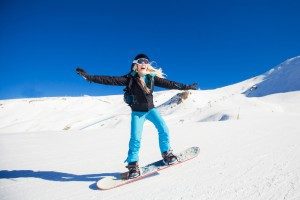Snowboarding : 7 Ways to Ride
Who would’ve ever imagined that a board with mounted bindings and a pair of specialized snow boots, would turn into a mass phenomenon? I mean, really … who knew? Not even Sherman Poppen imagined [in 1965] that his idea to fasten two skis together and attach a rope to the end of it to give his daughters more control as they glided downhill, would eventually turn into such a craze — and become all the rage on the slopes today.
Many other designers, such as Tom Sims, Jake Burton Carpenter, Mike Olson, and Dimitrije Milovich, built upon this idea by creating new board designs and components that slowly evolved into the snowboard that we are familiar with today.
Snowboarding is an exciting, thrilling, adrenaline pumping sport enjoyed by many — but has not always been a part of slope activity. Only after the snowboard quality improved, and snowboarders garnered more skill, did ski areas begin to welcome them, and ultimately designate separate slopes for them. And now today, approximately 97% of all ski areas allow snowboarding; and more than half of them have jumps, rails and half-pipes.
Whether you are just learning how to snowboard, or doing it for fun, sport, competition, adventure, or on a snowboarding vacation there are 7 different ways you can ride. And with a multitude of snowboard bindings to choose from, you’re guaranteed to find the perfect pair to accommodate your riding style. So rest easy troopers, we’ve got you covered!
Here are the riding styles that made our list:
Cruising – If you take the lift to the top, and snowboard back down without riding the terrain, then it’s safe to say, you’re just cruising.
Urban – If you’re riding features that exist outside the ski resort, such as, handrails, ledges, parking structures, walls, etc., then you my friend, are kicking it urban style! Younger riders dominate this type of snowboarding.
Powder Riding – If you’re riding in a thick layer of freshly fallen, untouched snow — not the hard-packed snow that you’re used to — and you feel like you are floating, then you are definitely powder riding. This type of riding is all about the speed, and requires a different set of techniques [skill level] than those used when riding on hard-packed snow — and it does not hurt as much when you crash.
Alpine – If your board, boot, and binding equipment visually resembles skiing equipment, and you purchased them for the purpose of improving your “carving” performance, then you are alpine snowboarding. Narrower, longer, stiffer boards; boots made of hard plastic shells; and bindings that have a bail or step-in design, is what differentiates this type of snowboarding from the rest.
Backcountry – If you’re skiing outside maintained and controlled ski area boundaries, such as, avalanche terrain, slopes and trails, then you are backcountry snowboarding. This type of snowboarding can be very dangerous, so do yourself a favor and seek training from the experts before engaging.
Freeride – If you are riding at your leisure in a terrain park, you are freeride snowboarding. Snowboarders that prefer this type of riding usually are — but not solely — in pursuit of massive peaks. Limited access to the mountains, and existing dangers (avalanche, crevasses), restrict how far freeriders can ride into distant areas.
Freestyle – If you are in an environment where riders perform features (acrobatics) and tricks (height, spinning) that closely resemble those seen in skateboarding, then you are most likely in a freestyle riding zone. This type of snowboarding can happen in terrain parks, backcountry, or urban environments, and is bound only by the snowboarders creativity.
So just as there’s a plethora of ways to enjoy the snow, there’s are many ways to enjoy snowboarding. And there’s no doubt, that with all the different styles out there, you will find one that works well for you. So gear up snowboarders and strap yourself in because it’s time to ride and let ride!
